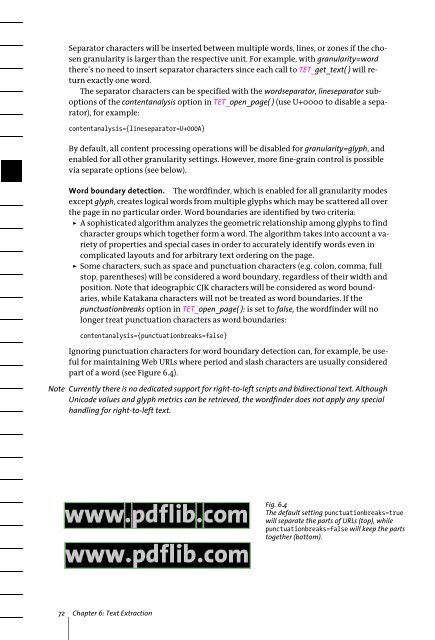PDFlib Text Extraction Toolkit (TET) Manual
PDFlib Text Extraction Toolkit (TET) Manual
PDFlib Text Extraction Toolkit (TET) Manual
Create successful ePaper yourself
Turn your PDF publications into a flip-book with our unique Google optimized e-Paper software.
Separator characters will be inserted between multiple words, lines, or zones if the chosen<br />
granularity is larger than the respective unit. For example, with granularity=word<br />
there’s no need to insert separator characters since each call to <strong>TET</strong>_get_text( ) will return<br />
exactly one word.<br />
The separator characters can be specified with the wordseparator, lineseparator suboptions<br />
of the contentanalysis option in <strong>TET</strong>_open_page( ) (use U+0000 to disable a separator),<br />
for example:<br />
contentanalysis={lineseparator=U+000A}<br />
By default, all content processing operations will be disabled for granularity=glyph, and<br />
enabled for all other granularity settings. However, more fine-grain control is possible<br />
via separate options (see below).<br />
Word boundary detection. The wordfinder, which is enabled for all granularity modes<br />
except glyph, creates logical words from multiple glyphs which may be scattered all over<br />
the page in no particular order. Word boundaries are identified by two criteria:<br />
> A sophisticated algorithm analyzes the geometric relationship among glyphs to find<br />
character groups which together form a word. The algorithm takes into account a variety<br />
of properties and special cases in order to accurately identify words even in<br />
complicated layouts and for arbitrary text ordering on the page.<br />
> Some characters, such as space and punctuation characters (e.g. colon, comma, full<br />
stop, parentheses) will be considered a word boundary, regardless of their width and<br />
position. Note that ideographic CJK characters will be considered as word boundaries,<br />
while Katakana characters will not be treated as word boundaries. If the<br />
punctuationbreaks option in <strong>TET</strong>_open_page( ): is set to false, the wordfinder will no<br />
longer treat punctuation characters as word boundaries:<br />
contentanalysis={punctuationbreaks=false}<br />
Ignoring punctuation characters for word boundary detection can, for example, be useful<br />
for maintaining Web URLs where period and slash characters are usually considered<br />
part of a word (see Figure 6.4).<br />
Note Currently there is no dedicated support for right-to-left scripts and bidirectional text. Although<br />
Unicode values and glyph metrics can be retrieved, the wordfinder does not apply any special<br />
handling for right-to-left text.<br />
Fig. 6.4<br />
The default setting punctuationbreaks=true<br />
will separate the parts of URLs (top), while<br />
punctuationbreaks=false will keep the parts<br />
together (bottom).<br />
72 Chapter 6: <strong>Text</strong> <strong>Extraction</strong>
















